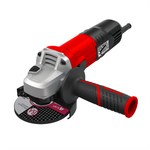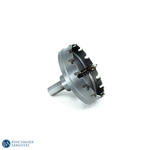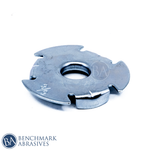
Understanding Angle Grinder Components and Their Uses

While using an angle grinder effectively is essential for getting the task done, being aware of its components is helpful in case something goes wrong. You must know the name of the parts of your angle grinder before fixing them or purchasing a replacement. You may learn more about the most common components of angle grinders in this article and what they do.
Key Elements Of An Angle Grinder
The following is a list of an angle grinder's essential components:
1. Power Lever
The power switch or power lever is the first component of an angle grinder that you need to be familiar with. A button, lever, or trigger is attached to the main handle. You can use this component to turn the angle grinder on and off as necessary.
2. Dial For Speed Control
The speed control dial is another crucial component, which is not always on all angle grinders. This function of the angle grinder can be found anywhere on the main handle and typically takes the form of a normal-looking dial or lever. You can change the speed at which the cutting disc revolves with this component.
3. Lock Button
The Lock Button is the third component of an angle grinder that you should be aware of. A button, lever, or trigger is attached to the main handle. You can use this component to turn the angle grinder on and off as necessary.
4. Side Handle
Another optional component of an angle grinder that most of them include is a side (or secondary) handle. This appears to be a stick-like metal or plastic protrusion with a textured rubber or plastic grip and a tall pommel at the end for a secure grip.
5. Main Handle
This is the central part of the angle grinder you hold in your dominant hand. Most controls, including the lock button, power trigger, and others, are located on that long, rounded protrusion from the angle grinder's head.
6. Body
The head of the angle grinder may also be referred to as the body. This area of the angle grinder houses the engine, the spindle, the blade, the main handle, and the side handles. One of the most critical components of an angle grinder, practically everything else is dependent on it somehow.
7. Engine
Another essential component of an angle grinder is the motor. Naturally, your angle grinder's motor generates its power and motion. Angle grinder motors are available in a range of power ratings, which depend on the type, standard, and cost.
8. Spindle
Other crucial components of the angle grinder are the spindle and its constituent pieces. The spindle, which holds the grinder head and blade, is the spherical protrusion on the bottom of the head or main body. As was already mentioned, a belt connecting the spindle and motor causes a fast, circular motion.
9. Blade Guard
Another crucial but removable component of an angle grinder is the blade guard. This is a semi-circular tool that faces the user and fastens to the underside of the angle grinder's main body or head. The front half of the blade, which contacts the workpiece, is free since the portion facing the operator is cut off.
10. Attachments
The angle grinder's rotating cutting or grinding component can also be equipped with various blades and discs. Cutting discs, sanding discs, grinding wheels, wire brushes, and flap discs are just a few blades and discs that can be utilized with angle grinders. Although they might not be considered part of an angle grinder, having a general understanding of them will help you use the equipment.
11. Power Cord
The angle grinder's power line or battery pack will be covered last. Of course, that motor needs electricity, which it can get straight from a wall socket or a battery pack. The battery pack or power wire will be attached to the end of the main handle.
Additional Components The Best Angle Grinder Should Have
1. Dust Ejection
High-quality angle grinders frequently use a dust ejection (or dust ejection system) to stop flying dust and debris from entering the electric motor through the cooling fan. This device ejects all tiny particles from the grinder's housing.
2. Protection From Overload
Overload protection is a crucial safety element when using the grinder for extended periods or complex tasks. Immediately cut off the tool's motor power until it has cooled down to stop it from overheating.
3. Handles With Anti-Vibration
For added comfort, anti-vibration handles cut the tool's vibration by up to 70%. The rubber cushioning layer that separates the anti-vibration handle from the spindle allows for easier control and higher precision when using the tool.
4. A Soft-Start Feature
Large angle grinders frequently have the soft-start feature. This function lessens the rapid "kick" on startup by enabling the tool to accelerate gradually to its top speed.
5. Slim Case
An angle grinder with a sleek, lightweight container is portable and straightforward to use in confined or awkwardly shaped locations. The instrument is very comfortable to carry for a long time thanks to this casing.
6. Keyless Security System
The keyless safety guard can be installed, removed, or modified without a unique power tool. This feature is helpful in workplaces where you must frequently update the device to accommodate different applications.
7. Brushes That Pop Off
In contrast to standard brushes, pop-off brushes will instantly break contact and cause the tool to shut down when they need to be replaced. The motor will be protected from harm as a result.
8. Enclosed Bearings
The motor's bearings are sealed to prevent dust from entering, assisting in maintaining a smooth rotation. There is even a circular plastic seal between the sealed bearings and the motor for further security
9. Quick-Release Method For Discs
The rapid disc-release method significantly reduces switching time between numerous discs and accessories. In other words, installing or removing discs, attachments, or backing flanges doesn't require using any tools.
Safety Measures To Consider
Following are some safety measures for safe practices when working with angle grinders:
-
Ensure to wear all the Protective gear like masks, shields, etc, for more safety while working with an angle grinder. It enables protection against any flying debris, sparks, or dust.
-
Ensure to use the correct grinding wheel or disc to do the job.
-
Examine the grinding wheels thoroughly for any cracks or damage before working. This ensures the safety of the operator as well as of the workpiece, as it might damage the workpiece and pose a risk to the user.
-
Always use the side handle of an Angle grinder for better control and accurate results. Ensure to grip gently.
-
Ensure to unplug and turn off the grinder after every use or while changing accessories.
CONCLUSION
As you can see, an angle grinder may seem like a simple tool, but it has a lot of critical parts that you should be familiar with. Now that you know each component purchasing a high-quality angle grinder, identifying problems with your current one, and performing repairs should be much more straightforward.



































































